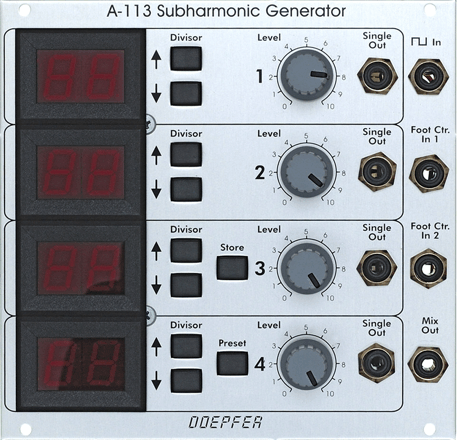
|
Über 2 Gate-Eingänge können bis zu 4 verschiedene "Mixturen" von aussen umgeschaltet werden. Dies kann z.B. über Fußschalter wie beim Trautonium oder mit anderen Gate-Signalen erfolgen. Bei 2 Gate-Eingängen sind 4 verschiedene Kombinationen möglich, daher 4 Mixturen (beim Original-Trautonium sind nur 3 verschiedene Mixturen möglich).
Das Modul A-113 besitzt zusätzlich einen Mixtur-Speicher, in dem 50 Presets abspeicherbar sind. Ein Preset besteht dabei aus einem Set von 4 mit den Gate-Eingängen umschaltbaren Mixturen, jede Mixtur besteht wiederum aus den 4 Werten für die Frequenzteiler. Ausführliche Informationen zum A-113 und zum gesamten Trautonium-Projekt finden Sie auf unseren Internet-Seiten. Folgende anderen Trautonium-Module sind verfügbar: Trautonium-Manual A-198, Trautonium-Filter A-104. Als Steueroszillator empfehlen wir den A-111-3, da dieser auch bei höheren Frequenzen ein sauberes 1V/Oktave-Tracking besitzt.
Eingänge: Master-Frequenz (Rechteck-Eingang), Foot Contr.1 + 2 (Gate 1+2)
Ausgänge: 4 Einzelausgänge, 1 Mixtur-Ausgang.
Die deutsche Bedienungsanleitung ist als PDF-Datei
auf unserer Website verfügbar: ![]() A113_anl.pdf.
A113_anl.pdf.

|
Two gate type control inputs enable to select between 4 different mixtures, i.e. 4 different settings of the frequency dividers. In the original Trautonium these are controlled by foot switches to switch between 3 mixtures while playing (the original Trautonium has only 3 mixtures available but with the 2 gate inputs of the A-113 four different settings can be adressed).
Additionally the A-113 features a mixture memory with 50 presets. Each preset consists of 4 mixtures that can be selected with the gate inputs, each mixture contains the values of the 4 frequency dividers.
More detailed information about the Trautonium can be found on our internet site in the Trautonium project article. These additional Trautonium modules are available: Trautonium Manual A-198, Trautonium Filter A-104. The A-111-3 is recommended as control VCO because the A-111-3 has an excellent 1V/octave tracking also for higher frequencies.
Inputs : master frequency (rectangle/pulse input), foot contr. 1 + 2 (gate
1+2)
Outputs: 4 single outputs, 1 mixture output
For more detailed information please look at the
English user's manual ![]() A113_man.pdf.
A113_man.pdf.
Tiefe/Depth: 90 mm (gemessen ab der Rückseite der Frontplatte / measured from the rear side of the front panel)
Strombedarf/Current:
- alte Version (16-poliges
Busverbindungskabel) / old version (16 pin bus connection cable) :
- + 30mA (+12V), -10mA (-12V) + 100mA@+5V
- neue Version (10-poliges
Busverbindungskabel) / new version (10 pin bus connection cable):
- +120 mA (+12V), -10 mA (-12), (keine zusätzlichen +5V erforderlich / no additional +5V required)
ACHTUNG!
Ältere Versionen des Moduls
A-113 benötigen eine zusätzliche +5V-Stromversorgung mit 100mA (z.B.
eigenes +5V-Netzteil oder +5V-Adapter)
Für alle ab Frühjahr
2015 ausgelieferten Module ist die 5V-Stromversorgung nicht mehr
erforderlich, da diese einen eigenen 5V-Regler (7805) auf dem Modul
besitzen
Die beiden Versionen können an Hand des Busverbindungskabels
unterschieden werden: alte Version = 16-polig, neue Version = 10-polig
ATTENTION !
Older versions of the A-113 module require an additional +5V power supply with 100mA (e.g. the separate +5V power
supply or the +5V low-cost adapter)
All modules shipped
from spring 2015 no longer require the additional +5V supply as these
modules have an 5V voltage regulator (7805) on board
The two versions can
be distinguished by means of the bus connection cable: old version = 16
wires, new version = 10 wires.
http://soundcloud.com/felixfoerster/nocturne-f-r-mixturtrautonium
http://soundcloud.com/felixfoerster/allego-f-r-mixturtrautonium
The price in US$ depends upon the exchange rate between Euro and US$ at the payment day.